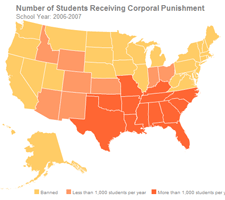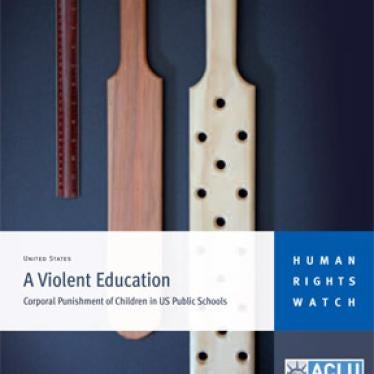More than 200,000 US public school students were punished by beatings during the 2006-2007 school year, Human Rights Watch and the American Civil Liberties Union said in a joint report released today. In the 13 states that corporally punished more than 1,000 students per year, African-American girls were twice as likely to be beaten as their white counterparts.
In the 125-page report, "A Violent Education: Corporal Punishment of Children in US Public Schools," the ACLU and Human Rights Watch found that in Texas and Mississippi children ranging in age from 3 to 19 years old are routinely physically punished for minor infractions such as chewing gum, talking back to a teacher, or violating the dress code, as well as for more serious transgressions such as fighting. Corporal punishment, legal in 21 states, typically takes the form of “paddling,” during which an administrator or teacher hits a child repeatedly on the buttocks with a long wooden board. The report shows that, as a result of paddling, many children are left injured, degraded, and disengaged from school.
“Every public school needs effective methods of discipline, but beating kids teaches violence and it doesn’t stop bad behavior,” said Alice Farmer, Aryeh Neier Fellow at Human Rights Watch and the ACLU, and author of the report. “Corporal punishment discourages learning, fails to deter future misbehavior and at times even provokes it.”
The report found that in the 13 southern states where corporal punishment is most prevalent, African-American students are punished at 1.4 times the rate that would be expected given their numbers in the student population, and African-American girls are 2.1 times more likely to be paddled than might be expected. There is no evidence that these students commit disciplinary infractions at disproportionate rates.
“Minority students in public schools already face barriers to success,” said Farmer. “By exposing these children to disproportionate rates of corporal punishment, schools create a hostile environment in which these students may struggle even more.”
 |
 Click on image to enlarge Click on image to enlarge |
Students with mental and physical disabilities are also punished at disproportionate rates, with potentially serious consequences for their development. In Texas, for instance, 18.4 percent of the total number of students who were physically punished were special education students, even though they make up only 10.7 percent of the student population.
"A Violent Education" is based on four weeks of on-the-ground research in Mississippi and Texas in late 2007 and early 2008, including more than 175 interviews with children, teachers, parents, administrators, superintendents, and school board members.
The report documents several cases in which children were beaten to the point of serious injury. Since educators who beat children have immunity under law from assault proceedings, parents who try to pursue justice for injured children encounter resistance from police, district attorneys, and courts. Parents also face enormous, sometimes insurmountable, obstacles in trying to prevent physical punishment of their children. While some school districts permit parents to sign forms opting out of corporal punishment for their children, the forms are often ignored.
In the report, Human Rights Watch and the ACLU cite experts on best practices in school discipline, who emphasize traditional approaches such as detention, and modern approaches such as positive behavior support systems. Positive behavior support systems, which are school-wide discipline systems that stress a clear structure of rewards and consequences for student behavior, have been effectively implemented in major US school systems. States and school boards that fail to implement best practices allow the status quo, or school beatings, to remain in place.
Human Rights Watch and the ACLU call upon the US government to prohibit corporal punishment in all public schools and urge state governments, school boards, superintendents, and administrators to eliminate physical punishment in their schools.
Selected Witness Accounts:
“He took me into the office and gave me three licks. … He made me hold onto the wall and he paddled me. … It hurt for about two hours, it felt like fire under my butt.”
– Matthew S., who was paddled in second grade for throwing food in a school cafeteria in the Mississippi Delta.“The other kids were watching and laughing. It made me want to fight them… When you get a paddling and you see everyone laugh at you, it make you mad and you want to do something about it.”
– Peter S., a middle school student in the Mississippi Delta.“What made me so angry: he’s three years old, he was petrified. He didn’t want to go back to school, and he didn’t want to start his new school. I was so worried that this was going to constantly be with him, equating going to school with being paddled.”
– Rose T., mother of a 3-year-old boy in Texas who was bruised from physical punishment after he refused to stop playing with his shoes in class.“I went into the principal’s office. … He gave me a chair and said hold onto the chair. The paddle had holes in it. Then he just did three swats. … I was hit on my buttocks. … There were holes in the paddle to make it go faster. … It hurt very much. There were definitely red marks and then swelling… almost welt-like markings. It didn’t last for more than a couple days. … It left me feeling very humiliated. I think there were several levels of emotion. Physical pain, mental humiliation. … And being a female at that age, it was like there was this older man hitting me on the butt. That’s weird… even at that age I knew it was inappropriate.”
– Allison G., a recent graduate punished as a teenager in Texas for being late to class multiple times.“I’ve heard this said at my school and at other schools: ‘This child should get less whips, it’ll leave marks.’ Students that are dark-skinned, it takes more to let their skin be bruised. Even with all black students, there is an imbalance: darker-skinned students get worse punishment.”
– Abrea T., former teacher in rural Mississippi.“I see corporal punishment as a form of slavery. Beating on the slaves was how the headman got them to do something… we’re focused so much on making kids do what we want. Think about the mental capacity that this kind of treatment leaves our children with. We are telling them we don’t respect them. They leave that principal’s office and they think, ‘they don’t consider me a human being.’ That young person loses self-respect.”
– Doreen W., school board member in a Mississippi Delta town.






